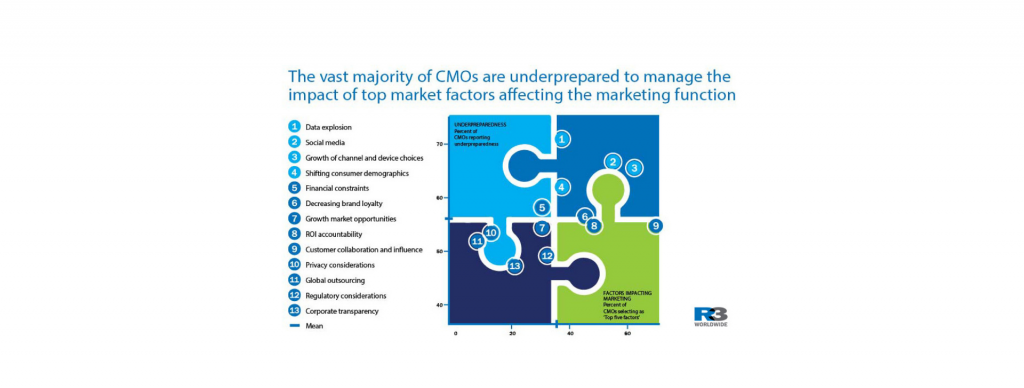by Greg Paull, Co-founder & Principal, R3
Big data and analytics are the most important – and most challenging – marketing tools CMOs need to get right. Companies are in the midst of a data-rich boon, fueled by mobile data, e-commerce and social sharing. The digital age is creating a huge stash of information that can deliver unprecedented insights into consumer behavior.
More Data, thanks to IoT
The growing popularity of the Internet of Things (IoT) will only increase the amount of data available to marketers. Gartner reported that 8.4 billion connected things were in use worldwide in 2017, with this number reaching 20.4 billion by 2020, which means that, even more than today, companies are going to be with their consumer every step of the way.
CMOs looking to implement customer-centric strategies do so not to only leverage data to provide highly relevant experiences, but to also generate relevant new data and use technology to make real-time personalized customer decisions where possible.
To quote Coca-Cola Senior Vice President and Chief Growth Officer, Francisco Crespo, “Data is a big enabler in understanding consumer behaviour. Not only the change but also the differential in behavior between offline and online. Machine learning is opening new possibilities on how data can be mined for core insights.”
A Blessing a Curse
However, a vast majority of CMOs consider themselves unprepared to manage the impact that digital disruption has on their own marketing functions, and the explosion of data at their fingertips is at the top of the list.
Data is the foundation that good digital marketing is built upon, but if not used correctly, it can also account for confusing leads, false paths, and scattered strategies. In short, the sheer amount of information we now have about consumers is both a blessing and a curse.
Here are three ways CMOs can make the most of their access to data:
#1. Eliminate Data Silos
Most organizations are swimming in first party data—data that comes to them directly from the consumer—that can come from marketing automation, social media, mobile apps, customer relationship management (CRM) data, and website usage. Then there is third party data streaming from other sources.
One challenge many organizations have is that data is siloed across an organization with little to no sharing happening between teams. This means strategies are being built with gaping blind spots, which can prevent the marketing team from having a holistic view of the organization’s consumers.
#2. Define a Data Analytics Strategy
For data to do its job, it’s important to have a data analytics strategy in place that will clearly improve a predetermined performance. Like e-commerce websites, each company must determine what they will build from the ground up, purchase, borrow, or rent.
In some cases, the ability to collect first-party data using deep, internal data and analytics expertise is invaluable—but for others, the investment outweighs the benefits. There are long-term third-party contracts to consider, or partnerships with customers, suppliers, and other marks along the supply chain.
The ideal solution might be a combination of the two, but ultimately finding the right combination that backs up the clear vision you have for the company and building the system around that should be top of mind.
#3. Integrating Brand and Data
While data has become a critical tool in deepening consumer insights and allowing for quicker reaction times, it is important to maintain classic methods of insight development to guide brand and strategy.
One should not be a replacement for the other and both need to work in tandem. Insights gathered from social listening and third-party digital data provide a richer and more well-rounded picture that can be used for brand strategy and development.
By using search data, you can not only tell how often your brand has been sought out, but also how closely it’s associated with your brand value proposition based on the click-through rate on keywords.
In essence, data is only useful when leveraged to better and more deeply understand a business. In other words, make the data work for you. As CMOs say again and again, the core of marketing has not changed, merely the vehicles with which to achieve goals have.

MARKETING Magazine is not responsible for the content of external sites.
After 20 years of evolving technology, shifting market trends, and adapting to changing consumer behaviour, the media landscape has nearly reached saturation.
We’ve optimised to the fullest, providing advertisers with abundant choices across technology, platforms, data-driven marketing, CTV, OTT, DOOH, influencer marketing, retail, etc.
Media specialists have diversified, but with more options comes the challenge of maintaining income growth. The industry is expanding, but revenue isn’t keeping pace.
Now, we’re at a TURNING POINT: time to explore and harness new sustainable revenue streams. While GroupM forecasts a 7.8% global ad revenue growth in 2024, challenges like antitrust regulation, AI and copyright issues, and platform bans persist.
Collaboration is key: partnerships that thrive on synergy, shared values, and aligned goals are becoming increasingly essential.
Hence, the Malaysian Media Conference, in its 20th year, has assembled the partners and players under one roof on October 25 for a day of learning, sharing, and exploring.
REGISTER NOW










